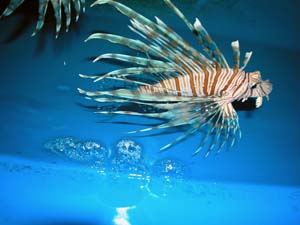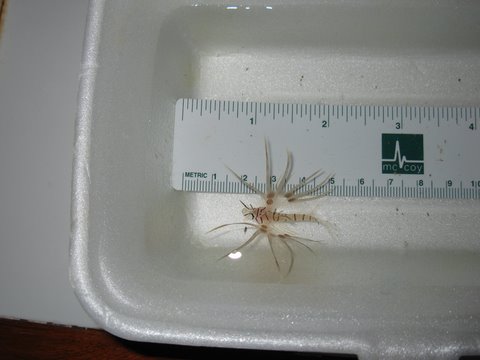Reproduction and Life Cycle
The devil firefish reaches maturity around two years of age. When lionfish are ready to mate, a male groups together several females. This whole time the male becomes extremely aggressive towards any other male who comes too close. If another male comes too close, the male will charge its competition and fight the intruding male by trying to head butt him with his bony face. This video shows two males fighting over mating privileges. http://www.youtube.com/watch?v=6xLNYpl0hKQ
A male will engage courtship by picking a female and sitting by her on the substrate. When lionfish are ready to mate, the male will become darker and the female will become paler. He will circle her a few times in a little dance. The female gets aroused by this little dance and follows the male excitedly to the surface. Once at the surface, the female will release a gelatinous ball filled with thousands of eggs. The male acts quickly and releases 10,000 to 30,000 sperm into the balls of eggs. After fertilization, the two want nothing to do with each other and go their separate ways. Lionfish are known to reproduce on a monthly basis all year round. According to (Morris, Sullivan, Govoni 2011), Pterois miles and Pterois volitans spawn identically.
Lionfish Eggs
Within 12 hours of fertilization, you can begin to distinguish between the eyes and tail. Within 36 hours of reproduction, the larvae will hatch and sink to the bottom of the ocean floor, where they consume ciliates and other small organisms. During the larval stage, they hide in crevices of rocks and corals. The larval stage of their lives last around 20-40 days. Lionfish grow extremely quickly and within two years are able to reproduce.
Photo credit : James Morris Taken from NOAA.gov
Juvenile Lionfish
Jerry Ligon Photography 10 June, 2010
Taken from http://www.thegreatoceans.com
Click on the Atlantic Lionfish button to read about lionfish in the Atlantic Ocean and why they are such a problem to local reef ecosystems.



